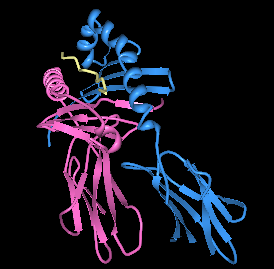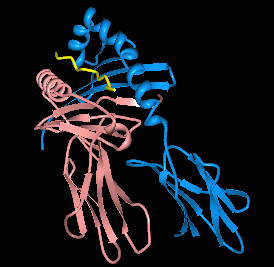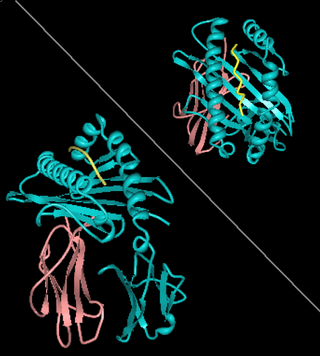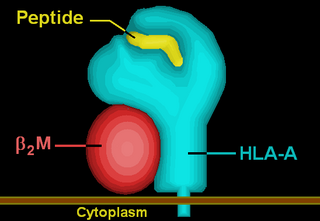
The human leukocyte antigen (HLA) system or complex is a complex of genes on chromosome 6 in humans which encode cell-surface proteins responsible for regulation of the immune system. The HLA system is also known as the human version of the major histocompatibility complex (MHC) found in many animals.

HLA-DQ (DQ) is a cell surface receptor protein found on antigen-presenting cells. It is an αβ heterodimer of type MHC class II. The α and β chains are encoded by two loci, HLA-DQA1 and HLA-DQB1, that are adjacent to each other on chromosome band 6p21.3. Both α-chain and β-chain vary greatly. A person often produces two α-chain and two β-chain variants and thus 4 isoforms of DQ. The DQ loci are in close genetic linkage to HLA-DR, and less closely linked to HLA-DP, HLA-A, HLA-B and HLA-C.

HLA-DQ8 (DQ8) is a human leukocyte antigen serotype within the HLA-DQ (DQ) serotype group. DQ8 is a split antigen of the DQ3 broad antigen. DQ8 is determined by the antibody recognition of β8 and this generally detects the gene product of DQB1*0302.

HLA-DQ2 (DQ2) is a serotype group within HLA-DQ (DQ) serotyping system. The serotype is determined by the antibody recognition of β2 subset of DQ β-chains. The β-chain of DQ is encoded by HLA-DQB1 locus and DQ2 are encoded by the HLA-DQB1*02 allele group. This group currently contains two common alleles, DQB1*0201 and DQB1*0202. HLA-DQ2 and HLA-DQB1*02 are almost synonymous in meaning. DQ2 β-chains combine with α-chains, encoded by genetically linked HLA-DQA1 alleles, to form the cis-haplotype isoforms. These isoforms, nicknamed DQ2.2 and DQ2.5, are also encoded by the DQA1*0201 and DQA1*0501 genes, respectively.

HLA-DQ4 (DQ4) is a serotype subgroup within HLA-DQ(DQ) serotypes. The serotype is determined by the antibody recognition of β4 subset of DQ β-chains. The β-chain of DQ is encoded by HLA-DQB1 locus and DQ4 are encoded by the HLA-DQB1*04 allele group. This group currently contains 2 common alleles, DQB1*0401 and DQB1*0402. HLA-DQ4 and HLA-DQB1*04 are almost synonymous in meaning. DQ4 β-chains combine with α-chains, encoded by genetically linked HLA-DQA1 alleles, to form the cis-haplotype isoforms. These isoforms, nicknamed DQ4.3 and DQ4.4, are also encoded by the DQA1*0303 and DQA1*0401 genes, respectively.

HLA-DQ6 (DQ6) is a human leukocyte antigen serotype within HLA-DQ (DQ) serotype group. The serotype is determined by the antibody recognition of β6 subset of DQ β-chains. The β-chain of DQ isoforms are encoded by HLA-DQB1 locus and DQ6 are encoded by the HLA-DQB1*06 allele group. This group currently contains many common alleles, DQB1*0602 is the most common. HLA-DQ6 and DQB1*06 are almost synonymous in meaning. DQ6 β-chains combine with α-chains, encoded by genetically linked HLA-DQA1 alleles, to form the cis-haplotype isoforms. For DQ6, however, cis-isoform pairing only occurs with DQ1 α-chains. There are many haplotypes of DQ6.

HLA-DQ7 (DQ7) is an HLA-DQ serotype that recognizes the common HLA DQB1*0301 and the less common HLA DQB1*0304 gene products. DQ7 is a form of 'split antigen' of the broad antigen group DQ3 which also contains DQ8 and DQ9.

HLA-DQ1 is a serotype that covers a broad range of HLA-DQ haplotypes. Historically it was identified as a DR-like alpha chain called DC1; later, it was among 3 types DQw1, DQw2 and DQw3. Of these three serotyping specificities only DQw1 recognized DQ alpha chain. The serotype is positive in individuals who bear the DQA1*01 alleles. The most frequently found within this group are: DQA1*0101, *0102, *0103, and *0104. In the illustration on the right, DQ1 serotyping antibodies recognizes the DQ α (magenta), where antibodies to DQA1* gene products bind variable regions close to the peptide binding pocket.

HLA-DR17 (DR17) is an HLA-DR serotype that recognizes the DRB1*0301 and *0304 gene products. DR17 is found at high frequency in Western Europe. DR17 is part of the broader antigen group HLA-DR3 and is very similar to the group HLA-DR18.

HLA-DR11 (DR11) is a HLA-DR serotype that recognizes the DRB1*1101 to *1110. DR11 serotype is a split antigen of the older HLA-DR5 serotype group which also contains the similar HLA-DR12 antigens.

HLA-DR3 is composed of the HLA-DR17 and HLA-DR18 split 'antigens' serotypes. DR3 is a component gene-allele of the AH8.1 haplotype in Northern and Western Europeans. Genes between B8 and DR3 on this haplotype are frequently associated with autoimmune disease. Type 1 diabetes mellitus is associated with HLA-DR3 or HLA-DR4. Nearly half the US population has either DR3 or DR4, yet only a small percentage of these individuals will develop type 1 diabetes.

HLA-DR4 (DR4) is an HLA-DR serotype that recognizes the DRB1*04 gene products. The DR4 serogroup is large and has a number of moderate frequency alleles spread over large regions of the world.

HLA-A1 (A1) is a human leukocyte antigen serotype within HLA-A "A" serotype group. The serotype is determined by the antibody recognition of α1 subset of HLA-A α-chains. For A1, the alpha "A" chain are encoded by the HLA-A*01 allele group and the β-chain are encoded by B2M locus. This group currently is dominated by A*01:01. A1 and A*01 are almost synonymous in meaning. A1 is more common in Europe than elsewhere, it is part of a long haplotype that appears to have been frequent in the ancient peoples of Northwestern Europe. A1 is a frequent component of the AH8.1 haplotype. A1 serotype positivity is roughly linked to a large number of inflammatory diseases and conditions believed to have immune system involvement. Because of its linkage within the AH8.1 haplotype many studies showed association with A1 or A1,B8 only later to show the association drift toward the class II region gene alleles, DR3 and DQ2.5. While it is not clear what role A1 has in infectious disease, some linkage with infection rates in HIV remain associated within the A1 region of the haplotype.

HLA-A3 (A3) is a human leukocyte antigen serotype within HLA-A serotype group. The serotype is determined by the antibody recognition of α3 subset of HLA-A α-chains. For A3, the alpha, "A", chain are encoded by the HLA-A*03 allele group and the β-chain are encoded by B2M locus. This group currently is dominated by A*03:01. A3 and A*03 are almost synonymous in meaning. A3 is more common in Europe, it is part of the longest known multigene haplotype, A3~B7~DR15~DQ6.

HLA-A33 (A33) is a human leukocyte antigen serotype within HLA-A serotype group. The serotype is determined by the antibody recognition of α33 subset of HLA-A α-chains. For A33, the alpha "A" chain are encoded by the HLA-A*33 allele group and the β-chain are encoded by B2M locus. A33 and A*33 are almost synonymous in meaning. A33 is a split antigen of the broad antigen serotype A19. A33 is a sister serotype of A29, A30, A31, A32, and A74.
HLA-Cw*16 (Cw*16) is an HLA-C allele-group. The serotype identifies the more common HLA-Cw*16 gene products. This allele group is most commonly found in West Africa, but A single Haplotype of Cw16 is found in Western Europe at unusually high frequencies. There is no useful serology for Cw*16.
HLA A1-B8-DR3-DQ2 haplotype is a multigene haplotype that covers a majority of the human major histocompatibility complex on chromosome 6. A multigene haplotype is set of inherited alleles covering several genes, or gene-alleles; common multigene haplotypes are generally the result of descent by common ancestry. Chromosomal recombination fragments multigene haplotypes as the distance to that ancestor increases in number of generations.
HLA A1-B8 is a multigene haplotype that covers the MHC Class I region of the human major histocompatibility complex on chromosome 6. A multigene haplotype is set of inherited alleles covering several genes, or gene-alleles; common multigene haplotypes are generally the result of identity by descent from a common ancestor. Chromosomal recombination fragments multigene haplotypes as the distance to that ancestor increases in number of generations.
HLA B7-DR15-DQ6 is a multigene haplotype that covers a majority of the human major histocompatibility complex on chromosome 6. A multigene haplotype is set of inherited alleles covering several genes, or gene-alleles, common multigene haplotypes are generally the result of descent by common ancestry. Chromosomal recombination fragments multigene haplotypes as the distance to that ancestor increases in number of generations.
HLA A30-Cw5-B18-DR3-DQ2 (A30::DQ2) is a multigene haplotype that extends across a majority of the major histocompatibility complex on human chromosome 6. A multigene haplotype is a set of inherited alleles covering several genes, or gene-alleles. Long haplotypes, like A30::DQ2, are generally the result of descent by common ancestry. As haplotypes increase in size, Chromosomal recombination fragments them in a generation dependent process.




